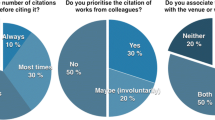Abstract
A graph theoretic approach from social network analysis allows size-dependent and size-independent bibliometric indicators to be identified from what is called the citation matrix. In an input–output sense, the number of references becomes the size-dependent measure of the input and the number of citations received by the journal from all journals in the network becomes the size-dependent measure of the output. However, in this paper, we are interested to compare two size-independent dimensionless indicators: the Pinski–Narin influence weight (IW) and the Ramanujacharyulu power-weakness ratio (PWR). These are proxies for the quality of the journal’s performance in the network. We show that at the non-recursive level, the two indicators are identical. At this stage these are simply measures of popularity. After recursion (i.e. repeated improvement or iteration) these become network measures of prestige of the journals. PWR is computed as a ratio of terms in the weighted citations vector and weighted references vector after the power and weakness matrices are separately recursively iterated. The Pinski–Narin procedure computes a matrix of ratios first and evaluates the IW after recursive iteration of this matrix of ratios. In this sense, the two procedures differ just like the RoA (ratio of averages) and the AoR (average of ratios) ways of computing relative citation indicators. We illustrate the concepts using datasets from subgraphs of 10 statistical journals and 14 Chinese chemistry journals with network data collected from the Web of Science. We are also able to show the confounding effects when self-citations are taken into account.




Similar content being viewed by others
References
Bensman, S. J. (2007). Garfield and the impact factor. Annual Review of Information Science and Technology, 41, 93–155.
Bergstrom, C. (2007). Eigenfactor: Measuring the value and prestige of scholarly journals. College and Research Libraries News, 68, 314.
Bollen, J., Rodriguez, M. A., & Van de Sompel, H. (2006). Journal status. Scientometrics, 69(3), 669–687.
Bollen, J., Van de Sompel, H., Hagberg, A., & Chute, R. (2009). A principal component analysis of 39 scientific impact measures. PLoS ONE, 4(6), e6022. https://doi.org/10.1371/journal.pone.0006022.
Brin, S., & Page, L. (2001). The anatomy of a large-scale hypertextual web search engine. In Proceedings of the seventh international conference of the World Wide Web (WWW1998) (pp. 107–117). available at http://infolab.stanford.edu/~backrub/google.html. Accessed 18 Aug 2014.
Cason, H., & Lubotsky, M. (1936). The influence and dependence of psychological journals on each other. Psychological Bulletin, 33(2), 95–103.
Daniel, R. S., & Louttit, C. M. (1953). Professional problems in psychology. Englewood Cliffs: Prentice-Hall Inc. https://doi.org/10.1037/11233-000.
David, H. A. (1971). Ranking the players in a round robin tournament. Review of the International Statistical Institute, 39, 137–147.
De Visscher, A. (2010). An index to measure a scientist’s specific impact. Journal of the American Society for Information Science and Technology, 61(2), 310–318.
De Visscher, A. (2011). What does the g-index really measure? Journal of the American Society for Information Science and Technology, 62(11), 2290–2293.
De Visscher, A. (2012). The thermodynamics-bibliometrics consilience and the meaning of h-type indices—Reply. Journal of the American Society for Information Science and Technology, 63(3), 630–631.
Garfield, E. (1972). Citation analysis as a tool in journal evaluation. Science, 178(4060), 471–479.
Garfield, E., & Sher, I. H. (1963). New factors in the evaluation of scientific literature through citation indexing. American Documentation, 14, 195–201.
Glänzel, W., & Schubert, A. (2018). Relative indicators revisited. ISSI Newsletter, 14(2), 46–50.
Kendall, M. G. (1955). Further contributions to the theory of paired comparisons. Biometrics, 11(1), 43–62.
Kessler, M. M. (1964). Some statistical properties of citations in the literature of physics (Ed.M. E. STEVENS). In Statistical Association Methods in Mechanized Documentation (Symposium Proceedings, 1964). Washington Nat. Bur.Std. 193–198 (1965).
Larivère, V., & Gingras, Y. (2011). Averages of ratios vs. ratios of averages: An empirical analysis of four levels of aggregation. Journal of Informetrics, 5(3), 392–399.
Leydesdorff, L. (2009). How are new citation-based journal indicators adding to the bibliometric toolbox? Journal of the American Society for Information Science and Technology, 60(7), 1327–1336.
Leydesdorff, L., de Nooy, W., & Bornmann, L. (2016). The power-weakness ratios (PWR) as a journal indicator: Testing the “tournaments” metaphor in citation impact studies. Journal of Data and Information Science, 1(3), 6–26. https://doi.org/10.20309/jdis.201617.
Leydesdorff, L., & Opthof, T. (2018). Revisiting relative indicators and provisional truths. ISSI Newsletter, 14(3), 62–67.
Pinski, G., & Narin, F. (1976). Citation influence for journal aggregates of scientific publications: Theory, with application to the literature of physics. Information Processing and Management, 12(5), 297–312.
Prathap, G. (2018). Eugene Garfield: From the metrics of science to the science of metrics. Scientometrics, 114(2), 637–650.
Prathap, G., & Nishy, P. (2016). An alternative size-independent journal performance indicator for science on the periphery. Current Science, 111(11), 1802–1810.
Prathap, G., Nishy, P., & Savithri, S. (2016). On the orthogonality of indicators of journal performance. Current Science, 111(5), 876–881.
Ramanujacharyulu, C. (1964). Analysis of preferential experiments. Psychometrika, 29(3), 257–261.
Todeschini, R., Grisoni, F., & Nembri, S. (2015). Weighted power–weakness ratio for multi-criteria decision making. Chemometrics and Intelligent Laboratory Systems, 146, 329–336.
West, J. D., Bergstrom, T. C., & Bergstrom, C. T. (2010). The eigenfactor metrics: A network approach to assessing scholarly journals. College and Research Libraries, 71(3), 236–244.
West, J. D., & Vilhena, D. A. (2014). A network approach to scholarly evaluation. In B. Cronin & C. R. Sugimoto (Eds.), Beyond bibliometrics (pp. 151–165). Cambridge: MIT Press.
Xhignesse, L. V., & Osgood, C. E. (1967). Bibliographical citation characteristics of the psychological journal network in 1950 and in 1960. American Psychologist, 22, 778.
Yan, E., & Ding, Y. (2010). Weighted citation: An indicator of an article’s prestige. Journal of the American Society for Information Science and Technology, 61(8), 1635–1643.
Author information
Authors and Affiliations
Corresponding author
Rights and permissions
About this article
Cite this article
Prathap, G. The Pinski–Narin influence weight and the Ramanujacharyulu power-weakness ratio indicators revisited. Scientometrics 119, 1173–1185 (2019). https://doi.org/10.1007/s11192-019-03046-7
Received:
Published:
Issue Date:
DOI: https://doi.org/10.1007/s11192-019-03046-7




